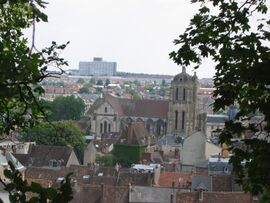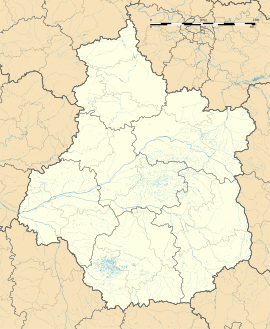درو
Dreux | |
|---|---|
Subprefecture and commune | |
 Saint-Pierre church | |
| الإحداثيات: 48°44′14″N 1°21′59″E / 48.7372°N 01.3664°E | |
| البلد | فرنسا |
| المنطقة | Centre-Val de Loire |
| الإقليم | Eure-et-Loir |
| الدائرة | Dreux |
| الكانتون | Dreux-1 and 2 |
| بينالتجمعات | CA Pays de Dreux |
| الحكومة | |
| • العمدة (2020–2026) | Pierre-Frédéric Billet[1] |
| المساحة 1 | 24٫27 كم² (9٫37 ميل²) |
| التعداد (يناير 2019) | 30٬646 |
| • الكثافة | 1٬300/km2 (3٬300/sq mi) |
| منطقة التوقيت | UTC+01:00 (CET) |
| • الصيف (التوقيت الصيفي) | UTC+02:00 (CEST) |
| INSEE/الرمز البريدي | 28134 /28100 |
| المنسوب | 75–139 m (246–456 ft) |
| 1 French Land Register data, which excludes lakes, ponds, glaciers > 1 km2 (0.386 sq mi or 247 acres) and river estuaries. | |
Dreux (النطق الفرنسي: [dʁø]) is a commune in the Eure-et-Loir department in northern France.
التاريخ
Dreux was known in ancient times as Durocassium, the capital of the Durocasses Celtic tribe. Despite the legend, its name was not related with Druids. The Romans established here a fortified camp known as Castrum Drocas.
في العصور الوسطى، كانت درو مركز كونتية درو. الكونت الأول لدرو كان روبير، ابن الملك لويس البدين. أول معركة كبيرة في حروب الدين الفرنسية نشبت في درو، في 19 ديسمبر 1562، وأسفرت عن نصر عزيز للقوات الكاثوليكية التابعة لـ duc de Montmorency.
In October 1983, the Front National won 55% of the vote in the second round of elections for the city council of Dreux, in one of its first significant electoral victories.[2]
التعداد
|
| ||||||||||||||||||||||||||||||||||||||||||||||||||||||||||||||||||||||||||||||||||||||||||||||||||||||||||||||||||
| Source: EHESS[3] and INSEE (1968-2017)[4] | |||||||||||||||||||||||||||||||||||||||||||||||||||||||||||||||||||||||||||||||||||||||||||||||||||||||||||||||||||
Sights
Chapelle royale de Dreux
In 1775, the lands of the comté de Dreux had been given to the Louis Jean Marie de Bourbon, duc de Penthièvre by his cousin Louis XVI. In 1783, the duke sold his domain of Rambouillet to Louis XVI. On 25 November of that year, in a long religious procession, Penthièvre transferred the nine caskets containing the remains of his parents, the Louis-Alexandre de Bourbon, comte de Toulouse and Marie Victoire de Noailles, comtesse de Toulouse, his wife, Marie Thérèse Félicité d'Este, Princess of Modène, and six of their seven children, from the small medieval village church next to the castle in Rambouillet, to the chapel of the Collégiale Saint-Étienne de Dreux.[5] The duc de Penthièvre died in March 1793 and his body was laid to rest in the crypt beside his parents. On 21 November of that same year, in the midst of the French Revolution, a mob desecrated the crypt and threw the ten bodies in a mass grave in the Chanoines cemetery of the Collégiale Saint-Étienne. In 1816, the duc de Penthièvre's daughter, Louise Marie Adélaïde de Bourbon, duchesse d'Orléans, had a new chapel built on the site of the mass grave of the Chanoines cemetery, as the final resting place for her family. In 1830, Louis-Philippe I, King of the French, son of the duchesse d'Orléans, embellished the chapel which was renamed Chapelle royale de Dreux, now the necropolis of the Orléans royal family.
Other sights
- Renaissance Château d'Anet
- Hôtel de Montulé (16th century)
- Pavilion of Louis XVI
- Hôtel de Salvat-Duhalde (18th century)
Personalities
Dreux was the birthplace of:
- Kalifa Cissé, footballer
- Martin Pierre d'Alvimare (1772–1839), composer and harpist
- Siraba Dembélé, handball player
- Abdou Dieye, footballer
- Chloe Gosselin, fiancee of magician David Copperfield
- Louis Victor Dubois (1837–1914), wine merchant and politician
- Rémi Gounelle (1967-), Protestant theologian
- Marouan Kechrid, basketball player
- Yannick Lesourd, athlete
- Antoine Godeau (1605–1672), bishop, poet and exegete. He is now known for his work of criticism Discours de la poésie chrétienne from 1633.
- Jean Rotrou (1609–1650), poet and tragedian
- Jean-Louis-Auguste Loiseleur-Deslongchamps (1774–1849), botanist
- Charles Delescluze (1809–1871), journalist and military commander of the Paris Commune
- Issa Samba, footballer
- Adrien Trebel (1991-), footballer
- Eddie London (1956–), singer
- François-André Danican Philidor (1726–1795), musician and chess player
- Guerschon Yabusele, basketball player
Twin towns - sister cities
Dreux is twinned with:[6]
See also
References
- ^ "Répertoire national des élus: les maires". data.gouv.fr, Plateforme ouverte des données publiques françaises (in الفرنسية). 2 December 2020. Retrieved 11 December 2020.
- ^ Gaspard, Françoise (1995). A Small City in France. Harvard University Press. ISBN 0-674-81096-1. Retrieved 2017-05-05.
- ^ قالب:Cassini-Ehess
- ^ Population en historique depuis 1968, INSEE
- ^ G. Lenotre, Le Château de Rambouillet, six siècles d'histoire, Calmann-Lévy, Paris, 1930, reprint: Denoël, Paris, 1984, (215 pages), chapter 5: Le prince des pauvres, pp. 78–79
- ^ "Les villes jumelées". dreux.com (in الفرنسية). Dreux. Retrieved 2019-11-22.
External links
- City council website (in French)
- Tourist office website
- Personal website about Dreux (in French)
- Pages using gadget WikiMiniAtlas
- صفحات بها مخططات
- CS1 الفرنسية-language sources (fr)
- Short description is different from Wikidata
- Coordinates on Wikidata
- Pages using infobox settlement with image map1 but not image map
- Articles with hatnote templates targeting a nonexistent page
- Communes of Eure-et-Loir
- مراكز الدوائر الادارية في فرنسا
- صفحات مع الخرائط



